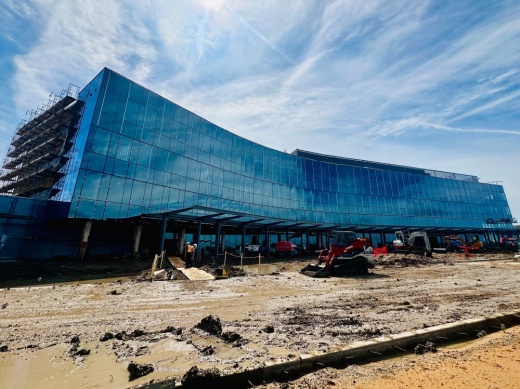The hospital will be located at the corner of the future Dallas North Tollway and FM 428. Having a major hospital within the city limits will significantly reduce the time it takes to get residents to emergency care, Celina Fire Division Chief Justin Beamis said.
“I’ve been on an [Emergency Medical Services] transport where we did CPR for 45 minutes across the county to Baylor McKinney when it was the only hospital we can go to,” Beamis said. “To know that we have the level of care coming into Celina that Methodist is going to give is a huge benefit for the community.”
The big picture
The new hospital is expected to treat its first patients in early 2025, Celina Methodist President Cody Hunter said. Its services will include emergency medicine, orthopedics, cardiology and general surgery.
OB-GYN services are expected to become available in summer 2025, Hunter said.
Before Methodist Celina, patients were sent to Denton, McKinney or Frisco for care, Hunter said.
“Celina is an emergency care desert,” he said.
Having a hospital nearby as the city continues to grow will support both its residents and visitors, Celina City Manager Robert Ranc said. The city’s population is expected to more than double in size by 2030 from 34,000 residents in 2023 to a projected 97,000 by 2030, according to U.S. Census data.
The four-story facility will include:
- $273 million project cost
- 40 acres of land
- 220-240 hospital employees
- 50 beds
- 3 operating rooms
- 2 procedure rooms
Diving deeper
A hospital opening creates a range of medical-related job opportunities, said Mary Ann Moon, Prosper Economic Development Corporation executive director. Jobs and positions will also be available at the administrative level, she said.
“It’s a huge domino effect on the creation of job opportunities,” Moon said.
The facility is projected to employ 200 people on its first day, and that number will expand as services are added.
The new hospital will bring health care closer to Prosper and Celina, which is a key component for seniors moving to the area to retire, Moon said. In 2022, Celina’s population included 14% of residents over age 65, according to census data. Approximately 8% of Prosper’s residents were age 65 or older in 2022.
“It’s such an asset for any of our older population to be able to have quick and easy access to essential medical services,” Celina Mayor Ryan Tubbs said.
What they’re saying
Robert Ranc, Celina City Manager: “As we continue to see the city grow, being able to have a place and a hospital to take people ... is certainly an increased level of support that we can offer to residents.”
Mario Canizares, Prosper Town Manager: “This development represents a significant milestone for our region, reflecting our commitment to enhancing health care access and quality for all residents in and around Prosper.”
Cody Hunter, Methodist Celina Medical Center President: “Just with the physical location, we’re literally going to change the way that lives are saved and emergency medicine is handled in this community.”
Mary Ann Moon, Executive Director of the Prosper Economic Development Corporation: “We want to make certain we are addressing needs all across the spectrum for people moving here, and health care is a big one.”
Stay tuned
Certifications such as trauma levels have not yet been determined, Hunter said.
Trauma levels refer to the resources available in a hospital’s trauma center. Levels in Texas range from Level IV as the lowest, which covers initial evaluation and stabilization, to Level I as the highest, which provides the highest level of surgical care to trauma patients, according to the Texas Department of State Health Services.
“Having access to top-of-the-line health care right around the corner is a tremendous improvement in quality of life,” Ranc said.
Hospital officials will work with local fire departments and EMS to decide what capabilities the hospital needs to serve the community.
“If you walk into the ER on day one with a broken bone, we’re going to have the resources there to be able to take care of you,” Hunter said.






